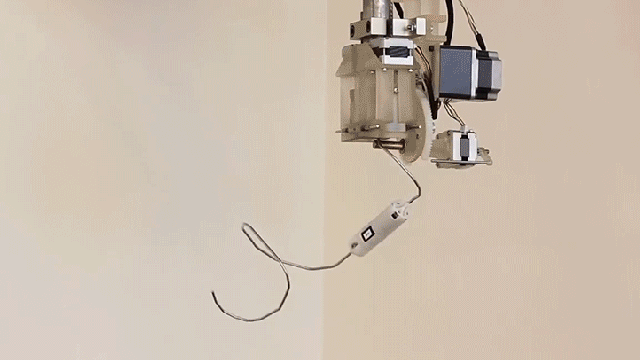Building a robot that can replicate everything a human can do is both impossibly complicated and expensive. So, researchers at the IT University of Copenhagen are taking the exact opposite approach: Building incredibly simple robots, on-demand, that only do what humans can’t.
In a paper recently published to the IEEE Robotics and Automation Letters journal, a team from the IT University of Copenhagen’s Robotics, Evolution and Art Lab — or, REAL, for short — led by associate professor Sebastian Risi, have developed what they’re calling a “1D printer” that can create simple wire-based robots designed to accomplish a very specific task.
The printer works in a manner similar to industrial wire-bending machines, extruding a length of thin metal which is bent in multiple places to create shapes that can be used as limbs or tools. The printer also automatically attaches electric motors to the wire structure as it’s being extruded, which bring the robots to life once they’re complete.
Due to the simplicity of their structure and components, the robots are limited in what they can do. They won’t be bringing you a glass of ice tea on demand, but the scientists see them being useful for exploring areas inaccessible to humans. One example sees a simple wire robot crawling limb-over-limb down a pipe, but the bot could be outfitted with a wireless camera for relaying video of a hard-to-reach area, or a sensor array for providing details about whether or not it’s safe for humans to proceed.
What makes this 1D printing technology unique, however, is that the robots don’t need to be physically designed by a human. The team has also developed an algorithm that can autonomously design a robot for a given task when fed its specific requirements and constraints. For instance, a rescue worker might need a robot that can walk on loose rubble, but also squeeze through a hole just a few centimetres in size.
The algorithm can also learn from design mistakes, when a robot it created has failed. It will simply design a new-and-improved model, again and again, until the requested task is accomplished. It sounds wasteful and time-consuming, but the robots take only about a quarter-of-an-hour to produce, and can be easily recycled by simply straightening the wire again.
The self-engineering aspect of these robots could make them useful when it comes to space exploration, and research on other worlds. When NASA designs a rover to explore a planet such as Mars, it tries to engineer it to tackle countless types of terrain. But if these rovers had a 1D printer on board, they could produce additional probes that were able to further explore parts of Mars the rover wasn’t originally designed to handle.
[IEEE Xplore via New Scientist]
